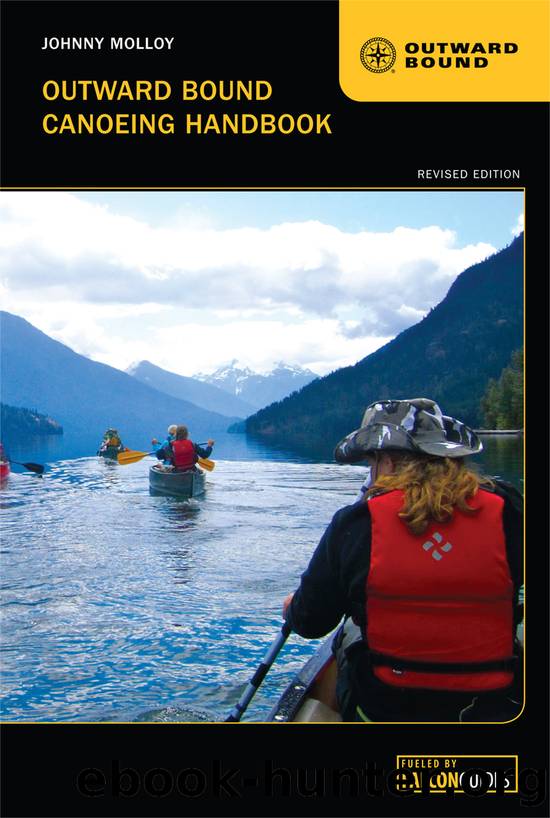Outward Bound Canoeing Handbook by Johnny Molloy

Author:Johnny Molloy
Language: eng
Format: epub
ISBN: 9781493007066
Publisher: Falcon Guides
Published: 2015-04-06T00:00:00+00:00
Waves
When the winds blow, the waves come right along with it. First-time canoers at places like Everglades National Park, Lake Superior, Yellowstone Lake, and other open-water destinations are often shocked at the size of waves they encounter. A powerful wind can blow a glassy bay into a choppy wave trap. Wind may slow your progress, but waves can capsize your craftâreal trouble. Make sure any valuable loose gear is tied tightly to the boat. When big winds are expected, try to paddle early in the morning when the winds and subsequent waves are generally lower. Consider paddling in the late afternoon or at night (using a GPS downloaded with topo maps or nautical charts) for the same reason. As a rule I try to start early not only to avoid the winds but also to give myself ample daylight to handle any unforeseen circumstances.
In big waves, try to modify your route to stay in sheltered waters or at least take breaks in sheltered waters when you can, to avoid exhausting yourself. Donât try to fight through waves. Roll over them, ride the crest, and drop into the trough as gently as possible, then pull yourself up and over the crest againââRide âem; donât fight âem.â
Canoeists have to be careful in waves and wind. First, try to avoid getting parallel to big waves, as they can go over the gunwales and swamp your boat. If you are heading in a direction parallel to the waves, paddle through them at an angle, zigzagging back and forth, not directly parallel to the waves. A wave crashing into the side of your canoe can be a quick capsizer. If water is splashing in, try to bail at intervals; otherwise the water coming in will lower the canoe, allowing more water in faster, finally culminating in a sinking. Have a bailing cup ready before entering big waves. Beware waves coming from behind; they can drop a lot of water in your boat when you are not looking.
When leaving the beach or other open shore in big water, aim your canoe straight toward the waves. Try to time your departure between wave surges, then paddle into the waves. Do not allow your boat to get broadside to the wavesâit will get filled with water and pounded back to shore.
Download
Outward Bound Canoeing Handbook by Johnny Molloy.epub
This site does not store any files on its server. We only index and link to content provided by other sites. Please contact the content providers to delete copyright contents if any and email us, we'll remove relevant links or contents immediately.
| Barbecuing & Grilling | Camping & RVs |
| Tailgating |
Project Smoke by Steven Raichlen(1994)
Smoke & Spice by Cheryl Alters Jamison(1880)
Extreme Food - What to Eat When Your Life Depends on It... by Bear Grylls(1758)
America's Best Ribs by Arthur Aguirre(1631)
America's Best Barbecue by Arthur Aguirre(1605)
Braai by Jan Braai(1551)
The Wood Pellet Smoker and Grill Cookbook by Peter Jautaikis(1549)
Indoor Grilling For Dummies by Lucy Wing & Tere Stouffer Drenth(1548)
The Power of Ashtanga Yoga by Kino MacGregor(1547)
Hungry Campers by Zac Williams(1502)
The Tex-Mex Cookbook by Robb Walsh(1440)
BBQ Joints by David Gelin(1421)
The Camp & Cabin Cookbook by Laura Bashar(1392)
20 Easy Recipes for Cast Iron Cooking by Adele Cliff(1384)
Ribs, Chops, Steaks & Wings by Ray Lampe(1375)
500 barbecue dishes by Kirk Paul(1347)
The Best of Southern Living Cookbook by The Editors of Southern Living(1330)
Celebrating Barbecue: The Ultimate Guide to America's 4 Regional Styles of 'Cue by Dotty Griffith(1245)
BEST SERVED WILD by BRENDAN LEONARD & ANNA BRONES(1203)
